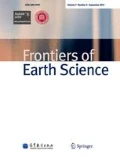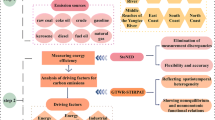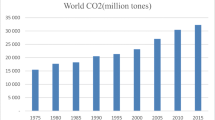Abstract
The rapid urbanization of China has increased pressure on its environmental and ecological well being. In this study, the temporal and spatial profiles of China’s carbon dioxide emissions are analyzed by taking heterogeneities into account based on an integration of the extended stochastic impacts using a geographically and temporally weighted regression model on population, affluence, and technology. Population size, urbanization rate, GDP per capita, energy intensity, industrial structure, energy consumption pattern, energy prices, and economy openness are identified as the key driving factors of regional carbon dioxide emissions and examined through the empirical data for 30 provinces during 2006‒2010. The results show the driving factors and their spillover effects have distinct spatial and temporal heterogeneities. Most of the estimated time and space coefficients are consistent with expectation. According to the results of this study, the heterogeneous spatial and temporal effects should be taken into account when designing policies to achieve the goals of carbon dioxide emissions reduction in different regions.
Similar content being viewed by others
References
Brunsdon C, Fotheringham A S, Charlton M (1999). Some notes on parametric significance tests for geographically weighted regression. J Reg Sci, 39(3): 497–524
Brunsdon C, Fotheringham A S, Charlton M E (1996). Geographically weighted regression: a method for exploring spatial nonstationarity. Geogr Anal, 28(4): 281–298
Brunsdon C, Fotheringham S, Charlton M (1998). Geographically weighted regression-modelling spatial non-stationarity. Journal of the Royal Statistical Society: Series D (The Statistician), 47(3): 431–443
Chen G Q, Chen Z M (2010). Carbon emissions and resources use by Chinese economy 2007: a 135-sector inventory and input–output embodiment. Commun Nonlinear Sci Numer Simul, 15(11): 3647–3732
Chen G Q, Zhang B (2010). Greenhouse gas emissions in China 2007: inventory and input-output analysis. Energy Policy, 38(10): 6180–6193
Chen Z M, Chen G Q (2011). Embodied carbon dioxide emission at supra-national scale: a coalition analysis for G7, BRIC, and the rest of the world. Energy Policy, 39(5): 2899–2909
Chen Z M, Chen G Q, Chen B (2013). Embodied carbon dioxide emission by the globalized economy: a systems ecological inputoutput simulation. Journal of Environmental Informatics, 21(1): 35–44
Dietz T, Rosa E A (1994). Rethinking the environmental impacts of population, affluence and technology. Hum Ecol Rev, 1: 277–300
Dietz T, Rosa E A (1997). Effects of population and affluence on CO2 emissions. Proc Natl Acad Sci USA, 94(1): 175–179
Fotheringham A S, Charlton M, Brunsdon C (1996). The geography of parameter space: an investigation of spatial non-stationarity. International Journal of Geographical Information Systems, 10(5): 605–627
Fotheringham S, Charlton M, Brunsdon C (1998). Geographically weighted regression: a natural evolution of the expansion method for spatial data analysis. Environ Plann A, 30(11): 1905–1927
Gelfand A E, Kim H J, Sirmans C F, Banerjee S (2003). Spatial modeling with spatially varying coefficient processes. J Am Stat Assoc, 98(462): 387–396
Huang B, Wu B, Barry M (2010). Geographically and temporally weighted regression for modeling spatio-temporal variation in house prices. Int J Geogr Inf Sci, 24(3): 383–401
Huang B, Zhang L, Wu B (2009). Spatiotemporal analysis of rural–urban land conversion. Int J Geogr Inf Sci, 23(3): 379–398
Ji X, Chen Z, Li J (2014). Embodied energy consumption and carbon emissions evaluation for urban industrial structure optimization. Front Earth Sci, 8(1): 32–43
Li J S, Alsaed A, Hayat T, Chen G Q (2014). Energy and carbon emission review for Macao’s gaming industry. Renew Sustain Energy Rev, 29: 744–753
Liu Y, Feng S, Cai S, Zhang Y X, Zhou X, Chen Y B, Chen ZM (2013). Carbon emission trading system of China: a linked market vs. separated markets. Front Earth Sci, 7(4): 465–479
Song B Y, Su F L (2010). GWR empirical research of Chinese provincial carbon emissions and economic development. Finance & Ecnomics, 4: 41–49 (in Chinese)
Xia X H, Chen Y B, Li J S, Tasawar H, Alsaedi A, Chen G Q (2014b). Energy regulation in China: objective selection, potential assessment and responsibility sharing by partial frontier analysis. Energy Policy, 66(0): 292–302
Xia X H, Hu Y, Chen G Q, Alsaedi A, Hayat T, Wu X D (2014a). Vertical specialization, global trade and energy consumption for an urban economy: a value added export perspective for Beijing. Ecol Modell
Xia X H, Hu Y, Tasawar H, Alsaedi A, Wu X D, Chen G Q (2015). Structure decomposition analysis for energy-related GHG emission in Beijing: urban metabolism and hierarchical structure. Ecol Inform, 26: 60–69
York R, Rosa E A, Dietz T (2003). STIRPAT, IPAT and ImPACT: analytic tools for unpacking the driving forces of environmental impacts. Ecol Econ, 46(3): 351–365
Zhang B, Chen G Q, Li J S, Tao L (2014). Methane emissions of energy activities in China 1980–2007. Renew Sustain Energy Rev, 29: 11–21
Acknowledgements
We thank two anonymous reviewers for their helpful comments on the earlier version of this paper and Dr. Leo Lester for proof reading. Valuable discussion and suggestions from Professor Tasawar Hayat and Professor Ahmed Alsaedi are highly appreciated. This study has been supported by the National Natural Science Foundation of China (Grant Nos. 71473242, 71403285, and 71403017), the National Basic Research Program of China (No. 2012CB955700), and the Strategic Priority Research Program of the Chinese Academy of Sciences (No. XDA05140300).
Author information
Authors and Affiliations
Corresponding authors
Electronic supplementary material
Rights and permissions
About this article
Cite this article
Liu, Y., Chen, ZM., Xiao, H. et al. Driving factors of carbon dioxide emissions in China: an empirical study using 2006-2010 provincial data. Front. Earth Sci. 11, 156–161 (2017). https://doi.org/10.1007/s11707-016-0557-4
Received:
Accepted:
Published:
Issue Date:
DOI: https://doi.org/10.1007/s11707-016-0557-4




